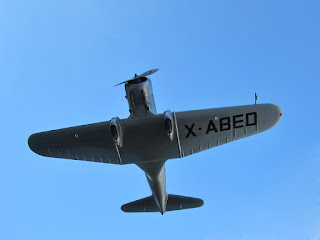The stubby but pleasant lines of the Delta are well-captured
in this nice kit.
Azur/FRROM have done a great job and have provided us with a
very good rendition of a much-beloved plane, in a civilian option!
As said in the step-by-step building post, this is a
well-natured kit that assembles easily and only needs a tweak here and there to
truly shine.
The unused parts in the sprues point, if I am not mistaken,
to a future release of the 1D/E variants (discussed in the building post). Those
variants had a number of nice civil liveries (Bendix "27", Ellsworth,
VH-ADR, Richfield Eagle, Honeywell, Coast Guard, etc., so let's hope the
manufacturer goes ahead and bestows upon us those variants.
Research (you know, that thing you do before creating a kit
or a model) shows that the Mexican machine I am representing here came in
several flavors. Photos show it with:
-Short exhaust stubs
-Long exhaust pipes
-The US
registration on top of the "X" (nat. reg. for Mexico) on the rudder (delivery
flight?)
-No US
reg on the rudder
-Tailwheel
-Tailskid or very small, solid, not really visible tailwheel
-External hinges on elevator (above and bellow, by the way,
not just above as the kit depicts them)
-No external hinges on the elevator
The usual unreliable, inaccurate and unconfirmed accounts on
the life of this plane are found on the Net, together with relevant pieces of
information (the kit's historical notes have it right, though). Sometimes it looks
like hardly anyone bothers with checking facts, just repeating whatever it's
found.
Some sources say the plane "blew up on the delivery
flight". Others state that the plane suffered catastrophic engine fire
upon days of operating. And others that the plane operated for a time, then
suffered the fire.
For what I found, the latter is the closest to the truth.
May be our Mexican brothers could shed some light on this
issue.
The kit and other drawings ask us to paint the rudder white.
Only one photo shows the rudder "white", all others show it metal
color. I have seen a number of photos where the reflection on the metal or
metallic paint gives the illusion of white, and I am convinced this is the
case.
This is as said a nice kit, and assembly is straightforward,
but there are a few minor things that need your attention, so if you are thinking
of building this one (highly recommended) please save yourself some time and
head-scratching and read the building post to pin-point the few things that
need a little work on them.
If you are going for the TWA variant, notice that at some
point it had park bench ailerons, which would be nice to represent (the
Williams Bros. Gamma kit has those ailerons).
Also notice that, as many photos prove, the registrations on the wing were parallel to the leading edge (as in many Gammas), and NOT perpendicular to the fuselage as shown in the kit's plan. I could not find a picture to check the correct position for the TWA characters on the wing.
Also notice that, as many photos prove, the registrations on the wing were parallel to the leading edge (as in many Gammas), and NOT perpendicular to the fuselage as shown in the kit's plan. I could not find a picture to check the correct position for the TWA characters on the wing.
If for some mysterious reason you feel the unquenchable urge
of building the Swedish machine, there is a nice book by Rob Mulder:
"Nothrop Delta AB Aerotransport" with many photos and detailed
information.
If you are a somewhat lazy modeler, you can close those cabin
curtains and do away with the cabin parts altogether, or you can go to town and
add as much detail as you want. If a 1D/E variant is released, I promise to
lower the split flaps ;-)
Some minor mods to the kit I felt like doing:
-Opening passenger door
-Adding the missing two elevator hinges
-Adding the two missing landing lights
-Adding the five vents on the roof
-Adding canopy rails
-Adding engine airscoop behind cowl on the right fuselage
side (for this Mexican machine)
-Adding navigation lights
-Adding seat belts
-Replacing the Northrop logo
-Adding curtains to the windows
-Adding some conduit seen in photos in cabin
Some marginal historical notes:
From
"EL
TRANSPORTE AÉREO DE CARGA DOMÉSTICA EN MÉXICO"
(The domestic cargo air transport in Mexico)
Oscar
Armando Rico Galeana
Publicación
Técnica No. 168
Sanfandila,
Qro,
En 1932 la PANAM creó una empresa
denominada Aerovías Centrales, S.A., con objeto de
tomar las rutas de otra empresa que
se había declarado en quiebra. En 1935, el Secretario de
Comunicaciones, Francisco Mújica,
hombre muy cercano al presidente Cárdenas, expidió una ley
que obligaba a que los pilotos de
aeronaves comerciales, con matrícula mexicana, fueran
mexicanos por nacimiento. PANAM se
mostró sumamente inconforme y en vez de cumplir con la
citada ley,
prefirió disolver Aerovías Centrales.
In 1932 PanAm created a company named
Aerovías Centrales, S.A., with the purpose of taking
over the routes that other company left vacant as it went bankrupt. In 1935,
the Communications Secretary Francisco Mujica, a man very close to president
Cárdenas, put in effect a law that mandated that all pilots operating in Mexico
on Mexican-registered commercial planes be born Mexicans. PanAm did not like
that a bit, and instead of complying with the law, preferred to dissolve
Aerovías Centrales.
Here compered with the ongoing Conqueror Gamma project:















































































Beautiful bird!
ReplyDeleteIsn't it so, Dieguito?
DeleteExcelente, felicitaciones, Armando Gil.
ReplyDeleteGracias, caballero Armando.
DeleteQué pena que no hubo más volando para otros países sudamericanos.